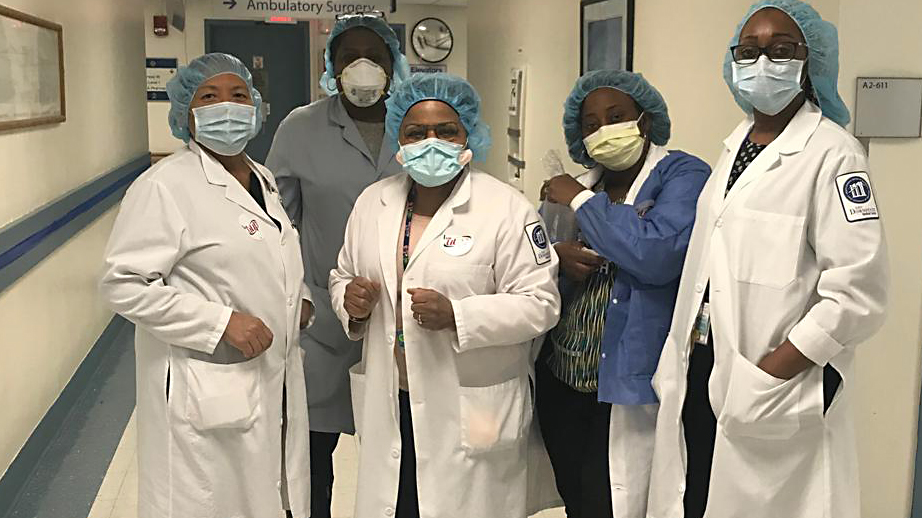April 1, 2020

As the magnitude of the coronavirus pandemic hits SUNY’s three teaching hospitals, UUP members are facing once-unimaginable upheaval by putting their patients first.
A field hospital rising on an athletic field. A frustrating inability to do testing on site in a hospital that has a world-class infectious disease department. Supplies of protective gear stretched so thin that masks intended for one use per patient are traveling from room to room with the physician wearing them.
These are just a few of the adjustments UUP hospital members have dealt with in the last few weeks.
And yet, members — like those from SUNY Downstate Health Sciences University, above — are more than rising to the occasion, with creativity and fortitude, in three teaching hospitals that saw their $87 million state subsidy cut two years ago. The hospitals have been running on the budget equivalent of fumes ever since then. In other parts of the state, healthcare workers have died of COVID-19.
In the SUNY teaching hospitals, members are quietly absorbing that grim news, handling their concerns and reassuring frightened patients, their chapter leaders say.
“These people are on the front lines; they are risking their lives to save the rest of us,” Carolyn Kube, the Stony Brook HSC Chapter president, said.
“These dedicated workers, who are our members, are heroes,” added UUP President Fred Kowal.
Downstate designated COVID only
And in one of the most dramatic developments, SUNY Downstate is now operating as a COVID-19-only hospital, on the governor’s March 29 order. Completely converting the hospital’s mission even as the crisis that prompted that order was underway proved to be a monumental effort – but Downstate members got it done.
“This is just the beginning,” Rowena Blackman-Stroud, the UUP Downstate Chapter president, said shortly after the order was announced. “Administration is closing all services, such as mammography and ob-gyn, and all surgical services are being closed so the only services the hospital will provide is for COVID-19. That includes testing and the caring of patients.”
Non-COVID patients will be transferred to other hospitals.
Making do with precious supplies
At SUNY Upstate Medical University, staff converted a large room to a sterilization center for N95 masks, using special lamps that emit ultraviolet light. The hospital might not be running through those precious masks quite as quickly had it received FDA approval to conduct COVID-19 tests on site, Upstate chapter president Richard Veenstra said.
Upstate was designated as a state testing site, but as of April 1, still had not received federal approval to start testing. Samples taken at Upstate are being sent to the state’s Wadsworth Center, a state laboratory in Albany.
“Right now, Upstate is good with gowns, gloves and regular masks,” Veenstra said. “They are trying to conserve, especially with the smaller N95 masks. [Staff] are told to use one mask for the entire day. One of the reasons we’re using so much personal protective equipment is we’re basically treating every patient as positive. We do need a faster turnaround on the tests. For whatever reason, Upstate has not gotten approval, even though we have recognized infectious disease experts. It is frustrating.”
Doing their best, and then some
At Stony Brook HSC, two floors were completely refurbished for treatment of COVID-19 patients. Tents for overflow from the emergency department, and for drive-through testing, have been set up in a parking lot. Members may feel fear, Kube said, “but they are doing what has to be done.”
Across the street, at the main Stony Brook University campus, a 1,037-bed temporary hospital tent is rising in an athletic field. That will be used for non-COVID patients, Stony Brook chapter president Ed Quinn said.
But there are still about 2,000 students on campus — most of them international students who cannot go home because of travel bans in their own countries — and UUP residence hall and student services staff must be on hand for them, Quinn said. He is concerned about the many questions the situation raises for the health and safety of both members and students.
“What we’re pushing for is, there needs to be some kind of training and protocol for student services staff,” he said. Adding to the concern: UUP members are still staffing the campus library — “Which doesn’t make any sense at all,” Quinn said — but these members are not being supplied with protective masks.
And members are coming in contact with other employees on campus, including bus drivers and food-services staff, whose health status is unclear, and who may not be wearing masks. The entire, unprecedented situation raises questions for which there are no quick answers.
Leaders tackling many issues
UUP statewide leaders are well aware of these issues. They continue to work with the Governor’s Office of Employee Relations and SUNY administration on matters such as staff redeployment, staff being asked to take on overnight shifts, and member safety during shortages of protective gear. And that is in addition to the ongoing effort to protect the work conditions of non-medical members who have faced the enormous shift to online education.
Kowal has been in regular communication with members through email updates and videos about the union’s ongoing conversations with SUNY and the governor’s office.
“We are making progress,” Kowal recently wrote to members. “We are also doing amazing work at protecting our members at the chapter/campus level, thanks to the hard work of our chapter presidents and labor relations specialists. And the work will continue for as long as the crisis continues.”
When asked what members who are not directly involved with health care during the crisis can do to support their colleagues who are truly on the front lines, Kube said that for now, one of the best ways to help is to acknowledge the heroic work being done.
Said Kube, “They should just say, ‘Thank you.’”

